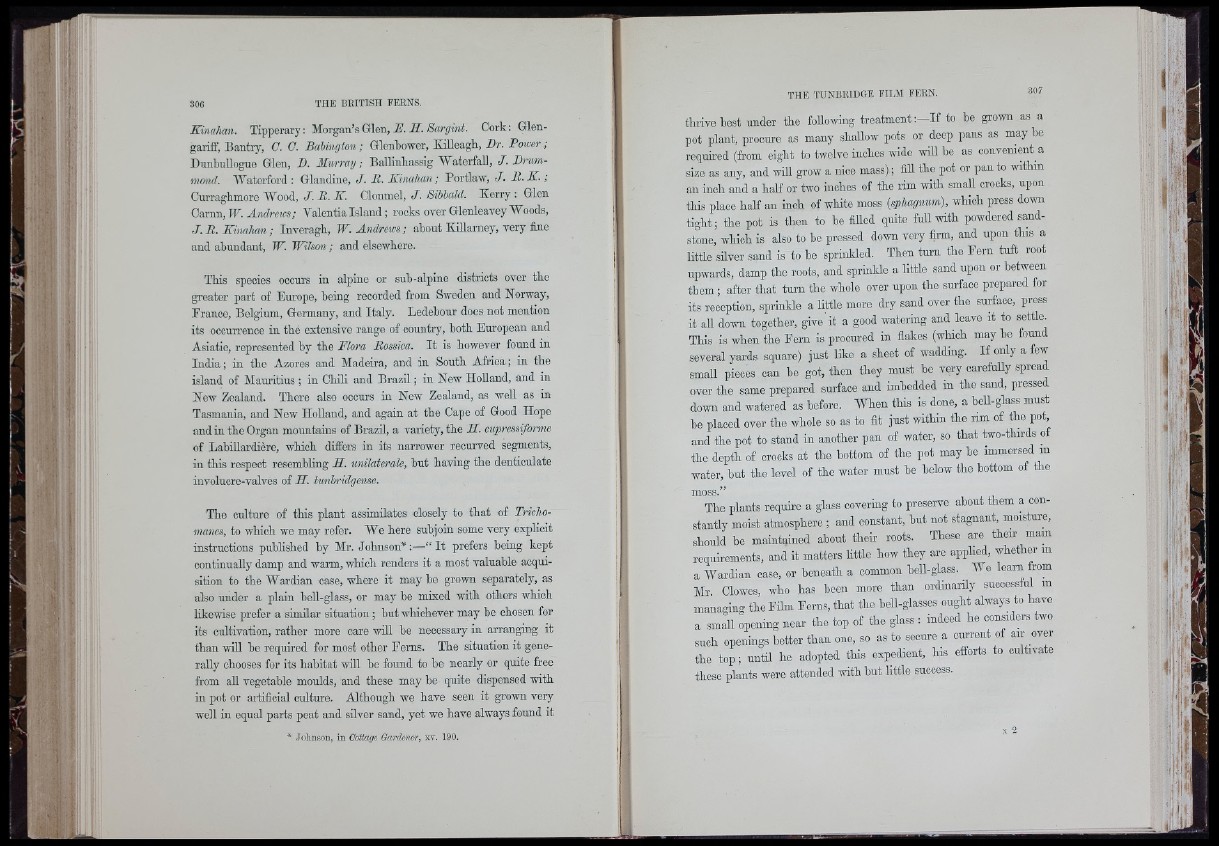
■i-’ :.:, j
i' - '
m
i J
L
Kinahan. Tipperary: Morgan’s Glen, E. II. Sargint. Cork: Glon-
gariff, Bantry, G. C. BaUngton; Glenbower, Ellcagh, Br. Forcer;
Dunbulloguo Glen, B. Murray; Ballinbassig Waterfall, J. Briim-
mond. Waterford: Glandiuo, J. R. Kinahan; Portlaw, J. R .K .;
Curragbmoro Wood, J. R. K. Clonmel, J. Sihhald. Kerry : Glen
GarcmfiV. Andrews; Valentia Island; rocks over Glenloavey Woods,
J. R. Kinahan; Inveragh, W. Andrews; about Ellarney, very fine
and abundant, W. Wilson; and elsewhere.
This species occurs in alpine or sub-alpine districts over the
greater part of Europe, hoing recorded from Sweden and Norway,
France, Belgium, Germany, and Italy. Ledebour does not mention
its ocourronoo in tho extensive range of country, both European and
Asiatic, represented by the Flora Rossica. It is however found in
India; in tho Azores and Madeira, and in South Africa; iu the
island of Mauritius ; in Chili and Brazil; iu New Holland, aud in
New Zealand. There also occurs in New Zealand, as weU as in
Tasmania, and New Holland, and again at the Cape of Good Hope
and in the Organ mountains of Brazil, a variety, the R . ctipressiforme
of Lahillardiere, which differs in its narrower recurved segments,
in this respect resembling R . unilaterale, hut having the denticulate
involucre-valves of H. tunhridgense.
The culture of this plant assimilates closely to that of Trichomanes,
to which wc may refer. We here subjoin some very explicit
iustruotions published by Mr. Johnson* :—“ It prefers being kept
continually damp and warm, which renders it a most valuable acquisition
to the Wardian case, where it may he grown separately, as
also under a plain bell-glass, or may be mixed with others which
likewise prefer a similar situation ; but whichever may he chosen for
its cultivation, rather more care will he necessary in arranging it
than wiU he required for most other Ferns. The situation it generally
chooses for its habitat will he found to be nearly or quite free
from all vegetable moulds, and these may be quite dispensed with
in pot or artificial culture. Although we have seen it grown very
well iu equal parts peat and silver sand, yet we have always found it
* Johnson, in Cottage Gardener^ xv. 190.
thrive best under the following treatment:—If to be grown as a
pot plant, procure as many shaUow pots or deep pans as may be
required (from eight to twelve inches wide will bo as convenient a
size as any, and will grow a nice mass); fill the pot or pan to within
an inch and a half or two inches of the rim with small crooks, upon
this place half an inch of white moss {sphagnum), which press down
tight; the pot is then to ho filled quite full with powdered sandstone,
which is also to he pressed down very firm, and upon this a
little silver sand is to be sprinkled. Then turn tho Fern tuft root
upwards, damp the roots, and sprinkle a littlo sand upon or between
them; after that turn the whole over upon the surface prepared for
its reception, sprinldo a little more dry sand over the surface, press
it all down together, give it a good watering and leave it to settle.
This is when the Fern is procured in flakes (which may bo found
several yards square) just like a sheet of wadding. If only a few
small pieces can he got, then they must be very carefully spread
over the same prepared surface and imbedded in the sand, pressed
down and watered as before. When this is done, a bcU-glass must
be placed over tho whole so as to fit just within the rim of the pot
and the pot to stand iu another pan of water, so that two-thirds of
tbe depth of crocks at the bottom of the pot may bo immersed in
water, hut the level of the water must bo below the bottom of the
moss.”
The plants require a glass covering to preserve about them a constantly
moist atmosphere ; and constant, but not stagnant, moisture,
should be maintained about their roots. These are their mam
requirements, and it matters little how they are applied, whether in
a Wardian ease, or beneath a common boU-glass. ^ We learn from
Mr. Clowes, who has been more than ordinarily sucoosslul in
managing the Film Ferns, that the bell-glasses ought always to have
a small opening near the top of the glass : indeed he considers two
such openings better than one, so as to secure a current of air over
the top; until he adopted this expedient, his efforts to cultivate
these plants were attended with hut little success.
i f f
J ,,.
ti' I
' I;
m